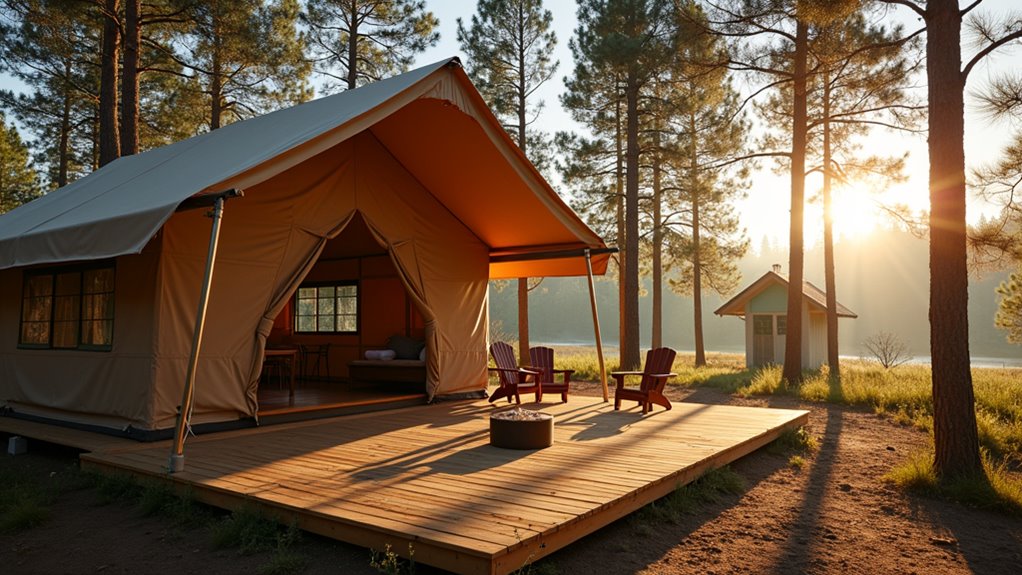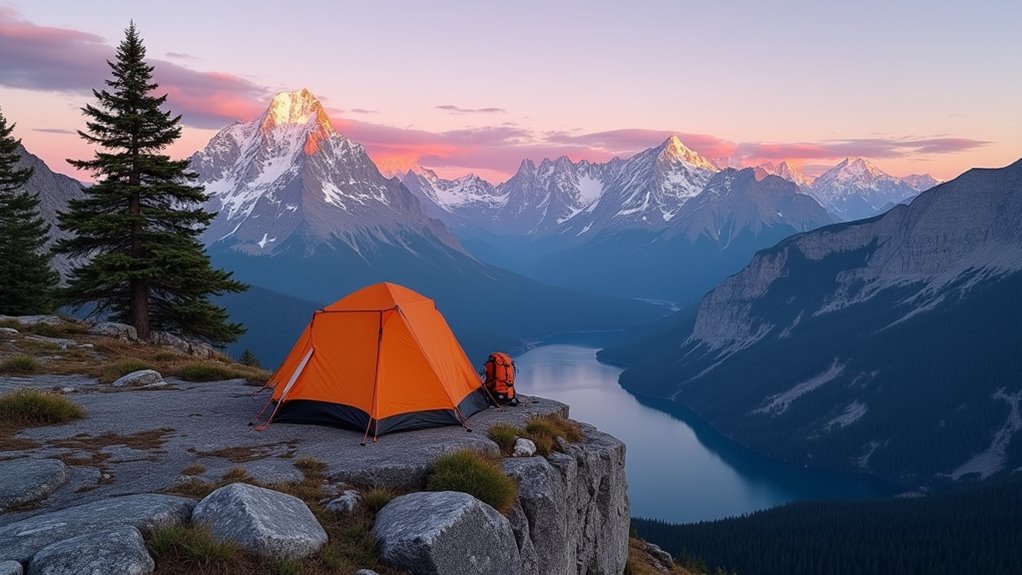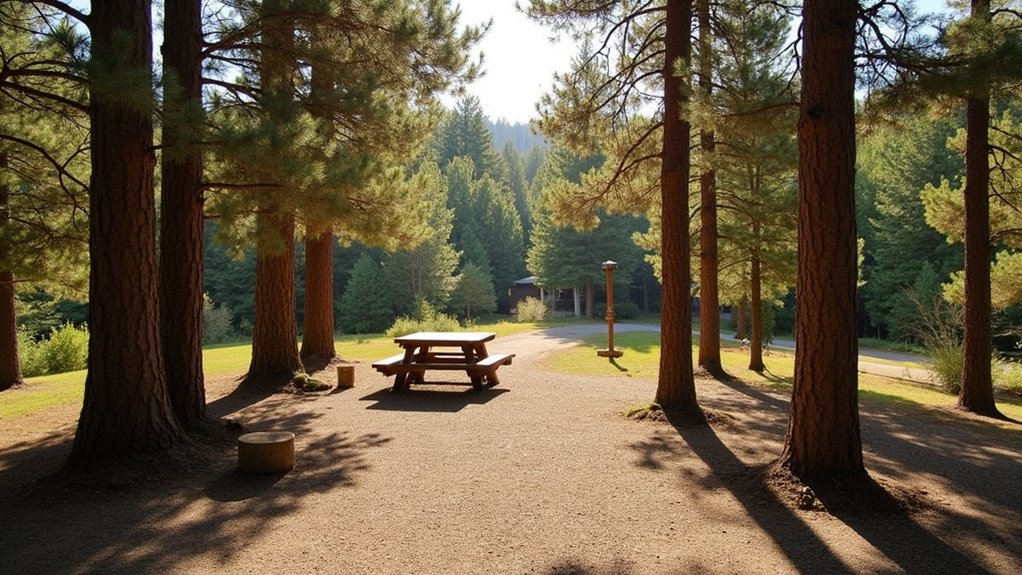Physical Address
304 North Cardinal St.
Dorchester Center, MA 02124
Physical Address
304 North Cardinal St.
Dorchester Center, MA 02124

Intrepid solo campers will discover these eight secluded yet secure destinations perfect for experiencing true wilderness without compromising safety.
Did you know that solo camping has increased by 47% since 2019, making it one of the fastest-growing outdoor activities? If you’re ready to join this growing trend, you should consider choosing locations that balance solitude with safety. From the well-patrolled trails of national parks to the hidden gems within BLM lands, each destination offers unique advantages for solo adventurers. Let’s explore eight distinct camping environments where you can find your perfect mix of independence and security.

While many outdoor destinations pose various risks for solo travelers, national parks stand out as remarkably safe havens for independent adventurers.
You’ll find violent crime rates 1,000 times lower than the national average, with only 8 deaths per 10 million visits from 2007 to 2024.
You can maximize your safety by following essential protocols: inform a trusted contact of your plans, maintain awareness of surroundings, and carry emergency signaling devices.
Nearly 40% of camping enthusiasts have ventured into solo camping, drawn to these protected natural spaces. Solo female campers can find empowering destinations within national parks.
Park infrastructure further enhances your security through staffed ranger stations, marked trails, and emergency call boxes.
You’ll benefit from visitor centers providing real-time alerts about weather, wildlife, and potential hazards.
These protected spaces offer both solitude and structure, combining vast natural beauty with regulated environments that guarantee your solo adventure remains both memorable and secure.
Because state parks offer an ideal blend of accessibility and security, you’ll find them perfectly suited for solo camping adventures. With over 6,600 locations across the U.S., you’re likely within a few hours’ drive of several options.
State parks provide the perfect balance of safety and convenience for solo campers, with thousands of locations just a short drive away.
You’ll benefit from professional ranger protection, well-maintained facilities, and established safety protocols. Most campsites come equipped with essential amenities like picnic tables, fire rings, and nearby restrooms. You can easily reserve your spot through online systems or mobile apps, ensuring a guaranteed space upon arrival.
The standardized rules at state parks help maintain order and safety. You’ll need to follow check-in procedures, observe quiet hours, and properly store food to avoid wildlife encounters. Many solo campers bring their dogs for safety while enjoying the park’s trails and lakes. Essential tips for a safe and enjoyable camping experience can help ensure your solo trip is a success.
With nearly one-third of campers now choosing solo adventures, you’ll join a growing community of independent outdoor enthusiasts.

Since established campgrounds provide extensive amenities, you’ll find them ideal for a comfortable solo camping experience without breaking the bank.
Private campgrounds offer full hookups at 51% of their sites, giving you access to water, electric, and sewer services. You’ll appreciate modern conveniences like WiFi, clean restrooms, and shower facilities that make solo camping more manageable. Essential tips for a great RV camping experience can help you make the most of your stay.
For added safety and comfort, you can choose sites near swimming pools and common areas where other campers gather. During peak camping season, approximately 76% of campsites are fully booked, so be sure to reserve well in advance.
If you don’t have an RV, many parks offer affordable alternatives like modern cabins or glamping units with kitchen facilities. Look for campgrounds with on-site staff and fenced areas, which provide extra security for solo travelers.
Most parks continue to expand their amenities and infrastructure, ensuring you’ll have everything you need.
RV parks offer a unique blend of independence and community for solo campers seeking long-term stays.
You’ll find full hook-up sites with water, electric, and sewer connections, plus modern amenities like Wi-Fi and coworking spaces that are perfect if you’re a workcationer.
These parks excel at creating networking opportunities through organized events, group hikes, and communal BBQ areas.
As a solo traveler, you can join potluck dinners and campfire gatherings while maintaining your desired level of privacy.
With nearly 30% of campers now traveling alone, you’ll find yourself in good company. Essential RV Camping Tips can help you make the most of your solo RV adventure.
Most parks provide clubhouses, fitness centers, and pools, making them ideal for extended stays.
Many campers bring their dogs for companionship while enjoying the social atmosphere of RV parks.
If you’re budget-conscious, you can opt for partial hook-up sites while still enjoying the social benefits and essential amenities these communities offer.

While backcountry wilderness areas offer the ultimate solo adventure, they’re best suited for experienced campers who’ve mastered essential outdoor skills.
You’ll need to secure permits and familiarize yourself with specific regulations, as most locations limit stays and restrict motorized equipment.
Top destinations include the Adirondacks, national forests, and designated wilderness areas, where you’ll find genuine solitude and pristine environments. Remember to observe all regulations regarding caching of gear, as all equipment must be packed out upon departure.
Experience true serenity in America’s unspoiled backcountry, from the rugged Adirondacks to the vast expanses of pristine national forests.
Camping can provide significant mental health benefits by allowing you to disconnect from daily stressors and reconnect with nature. Before heading out, make certain you’re equipped with navigation tools, emergency supplies, and first aid knowledge.
You’ll need to practice minimal impact principles, staying away from water sources and managing waste properly.
For solo campers seeking true freedom and solitude, Bureau of Land Management (BLM) lands offer an unmatched opportunity to camp across 245 million acres of public terrain. You’ll find dispersed camping sites that are free to use, with no reservations needed – just pick your spot and set up camp. You’ll need to follow basic rules: stay within 150 feet of established roads, camp at least 100 feet from water sources, and move to a new location after 14 days. Exciting camping activities can be enjoyed in these remote locations. Since you won’t find amenities like running water or restrooms, pack everything you’ll need for self-sufficient camping. Following the Leave No Trace principles is essential to protect and preserve these natural areas. Before heading out, grab BLM maps from regional offices, check fire restrictions, and plan for limited cell service. These remote locations reward you with peaceful solitude while keeping your camping budget minimal.

Private campgrounds offer families a perfect blend of outdoor adventure and modern convenience, with amenities that’ll keep everyone comfortable and entertained.
While these destinations primarily cater to families, you’ll find they can work surprisingly well for solo camping too. Top family-friendly campsites around the globe can also accommodate solo travelers.
You’ll discover well-maintained swimming pools, accessible trails, and on-site stores that eliminate extra trips into town. Many private campgrounds provide Wi-Fi connectivity and controlled entrance points, ensuring your safety while staying connected.
With over 13,000 private campgrounds across the U.S., you’ll have plenty of options to choose from, most individually owned and operated. Research shows that 14% prefer RV camping at these locations for enhanced comfort and amenities.
Though rates might be higher than public lands, you’re paying for convenience and security.
Consider visiting during off-peak seasons when families are less likely to travel for better rates and quieter surroundings.
National forest sites offer a completely different solo camping experience from private campgrounds, trading modern amenities for raw wilderness immersion.
You’ll find these remote sites scattered throughout undeveloped areas, often requiring hiking or off-road travel to access them.
While you won’t have toilets or treated water, you’ll enjoy free camping with stays up to 14-16 days. Bring necessary camping gear to ensure a comfortable and safe experience.
National forests trade modern comforts for extended free camping experiences, letting you truly disconnect from civilization for up to two weeks.
You’ll need to follow strict regulations: camp at least 100-200 feet from water sources, use only established fire rings when permitted, and pack out all trash.
During fire restrictions, opt for portable stoves instead of campfires.
Remember to obtain necessary permits for camping or firewood collection, and always practice Leave No Trace principles.
Store food securely to avoid wildlife encounters, and use catholes or portable toilets for waste disposal.
Many local forest service offices can provide detailed information about current conditions and specific camping regulations.
Whether you’re pitching your tent beneath Acadia’s star-studded skies or parking your RV among Joshua Tree’s ancient sentinels, solo camping doesn’t mean breaking the bank. You’ll find free dispersed sites on BLM lands, budget-friendly state park spots, and affordable national forest campgrounds. Pack your essentials, follow safety protocols, and embrace the solitude. These eight destinations offer the perfect balance of adventure and security for your solo journey.